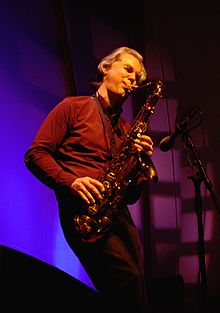Jan Garbarek
Jan Garbarek | |
|---|---|
 Jan Garbarek in Oslo in 2016 | |
| Background information | |
| Born | 4 March 1947 Mysen, Norway |
| Origin | Oslo, Norway |
| Genres | Jazz, classical, world |
| Occupation(s) | Musician |
| Instruments | Saxophone |
| Years active | 1966–present |
| Labels | ECM, Flying Dutchman |
| Associated acts | George Russell, Terje Rypdal, Bobo Stenson, Keith Jarrett, Ralph Towner, Eberhard Weber, Bill Frisell, David Torn, Gary Peacock, Hilliard Ensemble |
| Website | www |
Jan Garbarek (born 4 March 1947)[1] is a Norwegian jazz saxophonist, who is also active in classical music and world music.
Garbarek was born in Mysen, Norway, the only child of a former Polish prisoner of war, Czesław Garbarek, and a Norwegian farmer's daughter. He grew up in Oslo, stateless until the age of seven, as there was no automatic grant of citizenship in Norway at the time. When he was 21, he married the author Vigdis Garbarek. He is the father of musician and composer Anja Garbarek.[2]
Biography[]
Garbarek's sound is one of the hallmarks of the ECM Records label, which has released virtually all of his recordings. His style incorporates a sharp-edged tone, long, keening, sustained notes, and generous use of silence.[3] He began his recording career in the late 1960s, notably featuring on recordings by the American jazz composer George Russell (such as Electronic Sonata for Souls Loved by Nature). By 1973 he had turned his back on the harsh dissonances of avant-garde jazz, retaining only his tone from his previous approach. Garbarek gained wider recognition through his work with pianist Keith Jarrett's European Quartet which released the albums Belonging (1974), My Song (1977) and the live recordings Personal Mountains (1979), and Nude Ants (1979).[2] He was also a featured soloist on Jarrett's orchestral works Luminessence (1974) and Arbour Zena (1975).[4]


As a composer, Garbarek tends to draw heavily from Scandinavian folk melodies, a legacy of his Ayler influence. He is also a pioneer of ambient jazz composition, most notably on his 1976 album Dis a collaboration with guitarist Ralph Towner,[3] that featured the distinctive sound of a wind harp on several tracks. This textural approach, which rejects traditional notions of thematic improvisation (best exemplified by Sonny Rollins) in favour of a style described by critics Richard Cook and Brian Morton as "sculptural in its impact", has been critically divisive. Garbarek's more meandering recordings are often labeled as new-age music, or spiritual ancestors thereof. Other experiments have included setting a collection of poems of Olav H. Hauge to music, with a single saxophone complementing a full mixed choir; this has led to notable performances with Grex Vocalis. In the 1980s, Garbarek's music began to incorporate synthesizers and elements of world music. He has collaborated with Indian and Pakistani musicians such as Trilok Gurtu, Zakir Hussain, Hariprasad Chaurasia, and Bade Fateh Ali Khan.[3] Garbarek is credited for composing original music for the 2000 film Kippur.
In 1994, during heightened popularity of Gregorian chant, his album Officium, a collaboration with early music vocal performers the Hilliard Ensemble, became one of ECM's biggest-selling albums of all time, reaching the pop charts in several European countries and was followed by a sequel, Mnemosyne, in 1999. Officium Novum, another sequel album, was released in September 2010. In 2005, his album In Praise of Dreams was nominated for a Grammy Award. Garbarek's first live album Dresden was released in 2009.
Awards and honors[]
- 1999: Knight 1st Class of the Order of St. Olav
- 2004: Norwegian Arts Council Award
- 2014: Willy Brandt Award[5]
Discography[]
As leader[]
As sideman[]With Bill Connors
With David Darling
With Paul Giger
With Egberto Gismonti
With Trilok Gurtu
With Charlie Haden and Egberto Gismonti
|
With Zakir Hussain
With Keith Jarrett
With Giya Kancheli
With Eleni Karaindrou
With Kim Kashkashian
With Manu Katché
With Karin Krog
With Art Lande
With Marilyn Mazur
With Gary Peacock
With Terje Rypdal
With George Russell
With L. Shankar
With Ralph Towner
With Jan Erik Vold
With Miroslav Vitous
With Eberhard Weber
With Kenny Wheeler
|
References[]
- ^ Hultin, Randi (2002). "Garbarek, Jan". In Barry Kernfeld (ed.). The new Grove dictionary of jazz, vol. 2 (2nd ed.). New York: Grove's Dictionaries Inc. pp. 11–12. ISBN 1561592846.
- ^ Jump up to: a b "Jan Garbarek | Biography & History". AllMusic. Retrieved 11 October 2019.
- ^ Jump up to: a b c Colin Larkin, ed. (1997). The Virgin Encyclopedia of Popular Music (Concise ed.). Virgin Books. pp. 505/6. ISBN 1-85227-745-9.
- ^ "Keith Jarrett Discography". Jazzdisco.org. Retrieved 11 October 2019.
- ^ "Willy Brandt Stiftung - Willy Brandt stiftelsen". Willy-brandt-stiftelsen.no. Retrieved 11 October 2019.
External links[]
| Wikimedia Commons has media related to Jan Garbarek. |
- 1947 births
- Living people
- People from Eidsberg
- Avant-garde jazz musicians
- Spellemannprisen winners
- Norwegian people of Polish descent
- Freedom Records artists
- ECM Records artists
- 20th-century Norwegian saxophonists
- 21st-century Norwegian saxophonists
- Norwegian jazz saxophonists
- Norwegian jazz composers
- 20th-century saxophonists
- 20th-century Norwegian male musicians
- 21st-century Norwegian male musicians